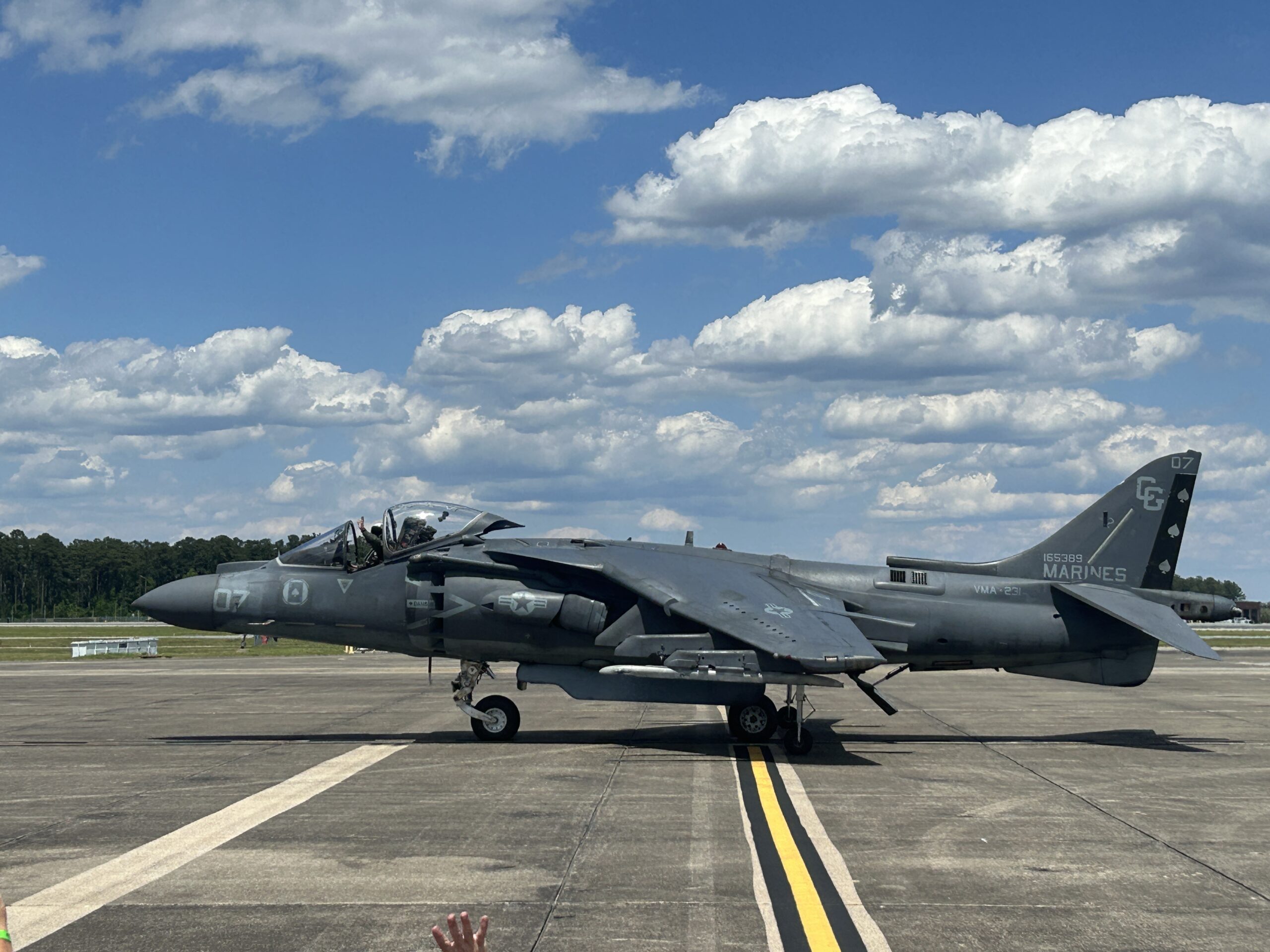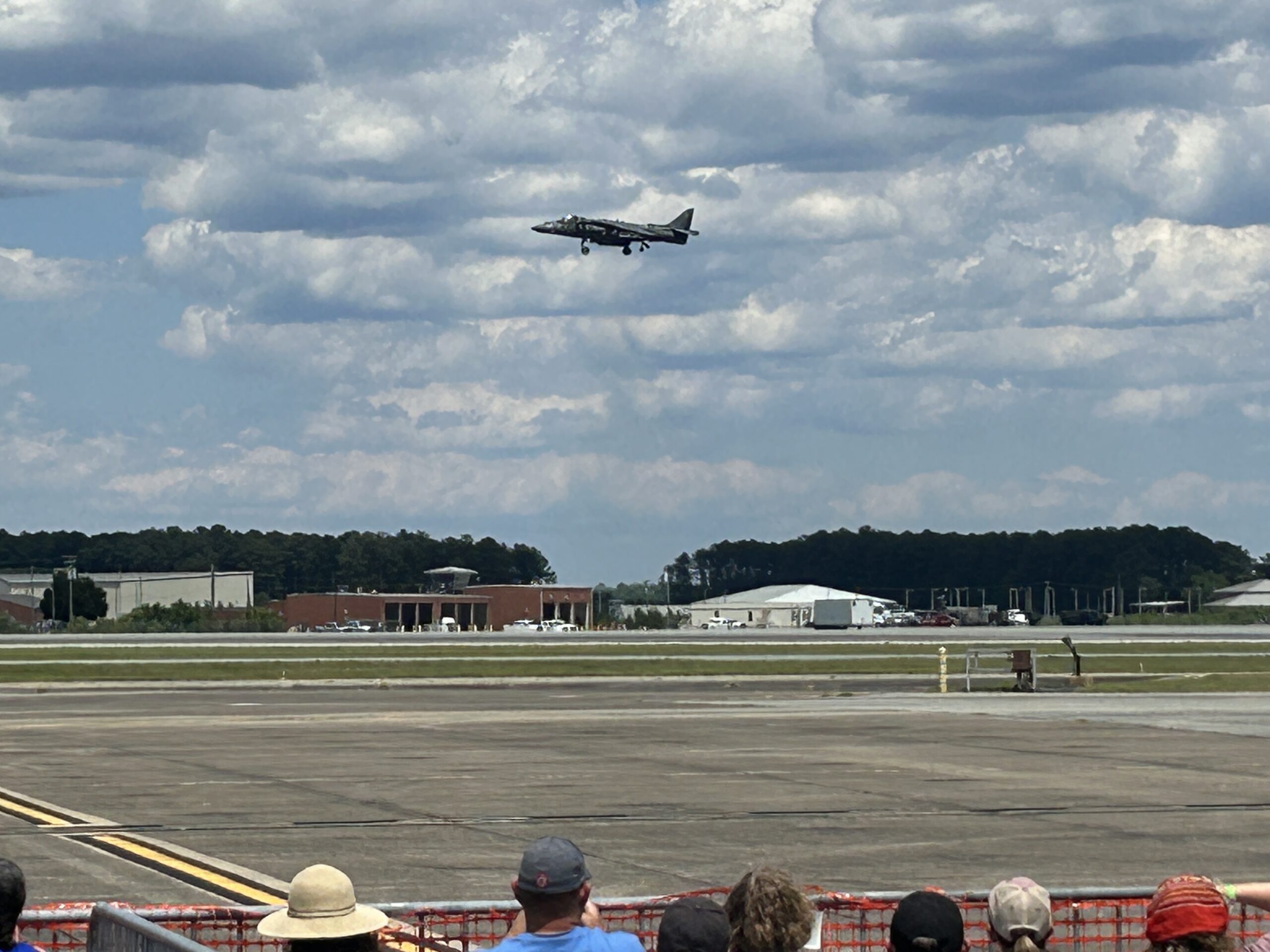
MARINE CORPS AIR STATION CHERRY POINT, N.C. – Just after noon on Sunday, a dark-gray AV-8B Harrier slashed across the cloud-embroidered eastern North Carolina sky at nearly 400 miles per hour, blasting by tens of thousands of spectators staring upwards at the jump jet’s last public demonstration.
The 2024 Marine Corps Air Station Cherry Point Air Show opened the previous day with at least 80,000 attendees. That stampede dwarfed the 16,000 or so residents of Havelock, a military town that boasts little more than the base and a collection of fast-food stop offs for beachgoers headed east.
Lt. Col. Paul Truog, commanding officer of the “Ace of Spades” of Marine Attack Squadron (VMA) 231 took the Harrier through its paces, wrestling the stick-and-rudder aircraft through simulated attack runs, high-G turns and an abrupt halt from 500 knots to a hovering standstill.
Truog then spun the vertical/short-takeoff-and-landing (VSTOL) jet through pirouettes and hover maneuvers using the last hydraulic flight control system in the U.S. military’s fighter inventory. With 2,000 hours in the Harrier, Truog will oversee his unit’s transition to the F-35B Lighting II Joint Strike Fighter beginning next year.
“This aircraft was designed to land on highways, rearm, refuel and get back to the fight,” said Capt. Michael Fucci, who narrated Truog’s demonstration flight. “It is impossible to find a Harrier pilot who wouldn’t say that it’s the most rewarding aircraft they’ve ever flown.”
Consolidated to several East Coast squadrons in 2022, Truog’s VMA-231 is the last unit flying the AV-8B II-plus, the most-modern version of the AV-8A originally built by Hawker-Siddeley in the United Kingdom and introduced in 1969. The AV-8B, built by McDonnell Douglas, which is now Boeing, first flew in 1981 and entered service four years later.
The II-plus version currently flown sports a more powerful version of the Rolls Royce Pegasus 11 engine that produces 23,800 pounds of thrust. It also features a forwarding-looking infrared (FLIR) sensor, night-vision goggle capability, APG-65 radar and targeting pod.
At least 80,000 aviation enthusiasts crowded the tarmac on Saturday, the first of two days packed with aerobatic performances and military aircraft demonstration that included the final public display of the Marines’ AV-8B.
The Harrier squadron completed its last deployment in March with the Bataan Amphibious Ready Group and the 26th Marine Expeditionary Unit, which operated in the Middle East and Mediterranean Sea for more than eight months.
It’s fitting that VMA-231 should usher out the Harrier’s service after four decades of service. The squadron was founded in 1919 at Marine Flying Field, Miami, having evolved from the Northern Bombing Group deployed to France during the World War I. The Marine Corps’ first aviation unit was then flying the Curtiss JN-4D Jenny biplane.
It soon will be equipped with the most-advanced fifth-generation short-takeoff and vertical landing aircraft flying, the F-35B, which will fill the role flown by the Harrier and the F-18 Hornet. Maj. Zachary Ybarra of Marine Fighter Fighter Attack Squadron 542 (VMFA-542) flew an F-35B earlier in the show.

After taxiing and taking off to Mötley Crüe’s “Kickstart My Heart,” Ybarra, a former Harrier pilot, demonstrated the F-35’s minimum radius turn, which pulled his body into the seat with seven times the force of gravity.
Where the stick-and-rudder, hydraulic-controlled Harrier has a slight but noticeable wobble in the hover, the fly-by-wire F-35B appears to sit absolutely still as if suspended by an invisible wire. The high-tech Lockheed Martin-built F-35 never deviated from its pilot-prescribed hover altitude as it performed spins and slides along the tarmac.
The Marine Corps Aviation Plan has the VMA-231 transitioning to the F-35B beginning next year and safe for flight with six STOVL jets in the third quarter of Fiscal Year 2026. The plan calls for a total 16 F-35Bs within 24 months from reaching initial operational capability.
A second squadron at Cherry Point, VMA-223, began operating six F-35Bs last fiscal year and should have its full complement of 16 aircraft by FY 2025, which begins Oct. 1.
Already flying the F-35B is VMFA-542, which received its first Lighting II in May 2023 and became the first East Coast squadron flying the jet after being declared safe for flight in August of that year. That squadron has already deployed to Evenes Air Station in Norway for the Nordic Response 2024 NATO exercises.
Cherry Point is also home to a Harrier training unit, VMAT-203, which flies both the AV-8B and TAV-8B two-seat training aircraft. That unit will sundown in FY 2026, according to the service’s aviation plan.
Perched atop brownish columns of superheated exhaust from its four swiveling nozzles and wingtips, Truog ended his demonstration with the Harrier’s signature hover-to-vertical-landing maneuver. Rising to a deafening roar, the AV-8B descended and touched gently down, bounced slightly on extended landing gear and ended its final demonstration flight.
Truog described the performance as “bittersweet.” But the show was not quite over.
To send the AV-8 out in a blaze of glory, another Harrier joined in the Marine Air-Ground Task Force demonstration later in the show. During a high-speed low flight over dismounted Marines flown in on both a CH-53E Super Stallion and the Marine Corps’ newest heavy-lift helicopter, the CH-53K King Stallion, another Harrier simulated an attack run, igniting an 800-foot wall of flames.




